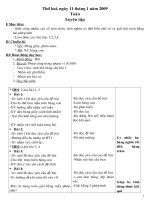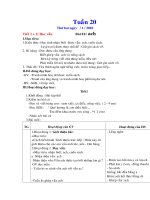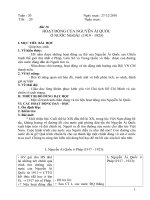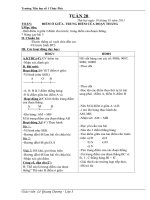Bài soạn Chapter 20 Organic Chemistry
Bạn đang xem bản rút gọn của tài liệu. Xem và tải ngay bản đầy đủ của tài liệu tại đây (5.12 MB, 153 trang )
Chapter 20
Organic
Chemistry
2011, NKMB Co., Ltd.
Chemistry, Julia Burdge, 2
st
Ed.
McGraw Hill.
Mr. Truong Minh Chien ;
/>
2
Overview
3
Structure Determines Properties
•
Organic compounds all contain carbon
CO, CO
2
, carbonates and carbides are inorganic
other common elements are H, O, N, (P, S)
•
Carbon has versatile bonding patterns
chains, rings, multiple bonds
chain length nearly limitless
•
Carbon compounds generally covalent
molecular; gases, liquids, or low melting solids;
varying solubilities; nonconductive in liquid
•
C - C bonds unreactive (very stable)
Chemistry, Julia Burdge, 2
nd
e., McGraw Hill.
4
Overview
•
Carbon uses sp
3
, sp
2
, and sp
hybridization in forming the four bonds
per carbon atom common to almost all
carbon compounds.
•
With sp hybridization, there are two (2)
π bonds and 2 σ bonds.
•
With sp
2
hybridization there is one (1) π
bond and 3 σ bonds.
Chemistry, Julia Burdge, 2
nd
e., McGraw Hill.
5
Why Carbon
sp3, sp2, and sp hybridization
Chemistry, Julia Burdge, 2
nd
e., McGraw Hill.
6
FUNCTIONAL GROUPS
1. Alkane
2. Alkene
3. Alkyne
4. Alkyl halide
5. Aromatic
6. Alcohol
7. Aldehyde
8. Ketone
9. Carboxylic Acid
10. Ester
11. Amine
12. Amide
Organic chemistry is the study of
compounds containing carbon.
The goal of studying Organic
chemistry is the making of
carbon-carbon bonds, C-X, C-O, C-N,
and C-S bonds to make new molecules
Inorganic molecules like CO, and
CO
3
-2
are not considered organic
molecules.
Chemistry, Julia Burdge, 2
nd
e., McGraw Hill.
7
Bond Energies and Reactivities
C-C 347 kJ
H
3
C-CH
3
NONREACTIVE
IN AIR
S-S 214 kJ HS-SH
EXTREMELY
REACTIVE
Si-Si 213 kJ
H
3
Si-SiH
3
SPONTANEOUS
BURNS IN AIR
N-N 159 kJ
H
2
N-NH
2
EXTREMELY
REACTIVE
O-O 138 kJ HO-OH
REACTIVE
Chemistry, Julia Burdge, 2
nd
e., McGraw Hill.
8
Allotropes of Carbon - Diamond
Chemistry, Julia Burdge, 2
nd
e., McGraw Hill.
9
Allotropes of Carbon - Graphite
Chemistry, Julia Burdge, 2
nd
e., McGraw Hill.
10
Carbon Bonding
•
mainly forms covalent bonds
•
C is most stable when it has 4 single covalent bonds, but
does form double and triple bonds
C=C and C≡C are more reactive than C−C
C with 4 single bonds is tetrahedral,
2 singles and 1 double is trigonal planar
2 doubles or 1 triple and 1 single is linear
Chemistry, Julia Burdge, 2
nd
e., McGraw Hill.
Tro, Chemistry: A Molecular Approach 11
Hydrocarbons
•
hydrocarbons contain only C and H
aliphatic or aromatic
•
insoluble in water
no polar bonds to attract water molecules
•
aliphatic hydrocarbons
saturated or unsaturated aliphatics
saturated = alkanes, unsaturated = alkenes or alkynes
may be chains or rings
chains may be straight or branched
•
aromatic hydrocarbons
12
Uses of Hydrocarbons
Number of
C atoms
State Major Uses
1-4 gas
heating and
cooking fuel
5-7
liquids,
(low boiling)
solvents,
gasoline
6-18 liquids gasoline
12-24 liquids
jet fuel; camp
stove fuel
18-50
liquids,
(high boiling)
diesel fuel,
lubricants,
heating oil
50+ solids
petroleum jelly,
paraffin wax
1-4 gas
heating and
cooking fuel
5-7
liquids,
(low boiling)
solvents,
gasoline
6-18 liquids gasoline
12-24 liquids
jet fuel; camp
stove fuel
18-50
liquids,
(high boiling)
diesel fuel,
lubricants,
heating oil
50+ solids
petroleum jelly,
paraffin wax
Tro, Chemistry: A Molecular Approach 13
Saturated Hydrocarbons
•
a saturated hydrocarbon has all C-C single
bonds
it is saturated with hydrogens
•
saturated aliphatic hydrocarbons are called
alkanes
•
chain alkanes have the general formula C
n
H
2n+2
Tro, Chemistry: A Molecular Approach 14
Unsaturated Hydrocarbons
•
unsaturated hydrocarbons have one of more C=C
double bonds or C≡C triple bonds
•
unsaturated aliphatic hydrocarbons that contain C=C are
called alkenes
the general formula of a monounsaturated chain alkene is
C
n
H
2n
remove 2 more H for each additional unsaturation
•
unsaturated aliphatic hydrocarbons that contain C≡C are
called alkynes
the general formula of a monounsaturated chain alkyne is
C
n
H
2n-2
remove 4 more H for each additional unsaturation
Tro, Chemistry: A Molecular Approach 15
Unsaturated Hydrocarbons
CH
3
C
H
C
H
CH
3
CH
3
C C CH
3
CH
3
C
C
CH
3
CH
3
CH
3
CH
CH
2
C
H
2
CH
2
CH
2
C
H
CH
2
CH
2
C
H
2
C
H
2
CH
2
CH
2
C
H
2
C C
C
H
2
C
H
2
CH
2
CH
2
C
H
2
C
H
2
CH
2
Tro, Chemistry: A Molecular Approach 16
Aromatic Hydrocarbons
•
contain benzene ring structure
•
even though they are often drawn with C=C,
they do not behave like alkenes
Tro, Chemistry: A Molecular Approach 17
alkanes
CH
3
C
H
C
H
CH
3
CH
3
C
C
CH
3
CH
3
CH
3
CH
CH
2
C
H
2
CH
2
CH
2
C
H
alkenes
CH
3
C C CH
3
CH
2
CH
2
C
H
2
C
H
2
CH
2
CH
2
C
H
2
C C
C
H
2
C
H
2
CH
2
CH
2
C
H
2
C
H
2
CH
2
alkynes
Tro, Chemistry: A Molecular Approach 18
19
Formulas
•
molecular formulas just tell you what kinds
of atoms are in the molecule, but they don’t
tell you how they are attached
•
structural formulas show you the
attachment pattern in the molecule
•
models not only show you the attachment
pattern, but give you an idea about the
shape of the molecule
Tro, Chemistry: A Molecular Approach 20
Condensed Structural Formulas
•
attached atoms listed in order
central atom with attached atoms
•
follow normal bonding patterns
use to determine position of multiple bonds
•
() used to indicate more than 1 identical
group attached to same previous central
atom
unless () group listed first in which case
attached to next central atom
Tro, Chemistry: A Molecular Approach 21
Line-Angle Formulas
•
each angle, and beginning and end represent a C
atom
•
H omitted on C
included on functional groups
•
multiple bonds indicated
double line is double bond, triple line is triple bond
Tro, Chemistry: A Molecular Approach 22
Formulas
Tro, Chemistry: A Molecular Approach 23
Formulas
CH
4
C
H
H
H
H
C
2
H
6
CH
3
CH
3
C
H
C
H
H
H
H
H
C
3
H
8
CH
3
CH
2
CH
3
C
H
C
H
H
H
C
H
H
H
H
C
4
H
10
CH
3
CH
2
CH
2
CH
3
C
H
C
H
H
H
C
H
H
C
H
H
H
H
C
4
H
10
C(CH
3
)
2
C
H
C
H
H
H
C
C
H
H
H
H
H
H
24
Name
# of
C's
Structural Formula
BP
(C°)
MP
(C°)
methane 1
CH
4
-161 -183
ethane 2
CH
3
CH
3
-88 -172
propane 3
CH
3
CH
2
CH
3
-45 -187
butane 4
CH
3
CH
2
CH
2
CH
3
-.5 -138
pentane 5
CH
3
CH
2
CH
2
CH
2
CH
3
36 -130
hexane 6
CH
3
CH
2
CH
2
CH
2
CH
2
CH
3
69 -95
heptane 7
CH
3
CH
2
CH
2
CH
2
CH
2
CH
2
CH
3
98 -90
octane 8
CH
3
CH
2
CH
2
CH
2
CH
2
CH
2
CH
2
CH
3
125 -57
nonane 9
CH
3
CH
2
CH
2
CH
2
CH
2
CH
2
CH
2
CH
2
CH
3
151 -54
decane 10
CH
3
CH
2
CH
2
CH
2
CH
2
CH
2
CH
2
CH
2
CH
2
CH
3
175 -30
Tro, Chemistry: A Molecular Approach 25
Isomerism
•
Isomers = different molecules with the same
molecular formula
•
Structural Isomers = different pattern of atom
attachment
Constitutional Isomers
•
Stereoisomers = same atom attachments, different
spatial orientation









